Cycle News Staff | May 18, 2017
Aprilia Comes Out With All V4 Guns Blazing!
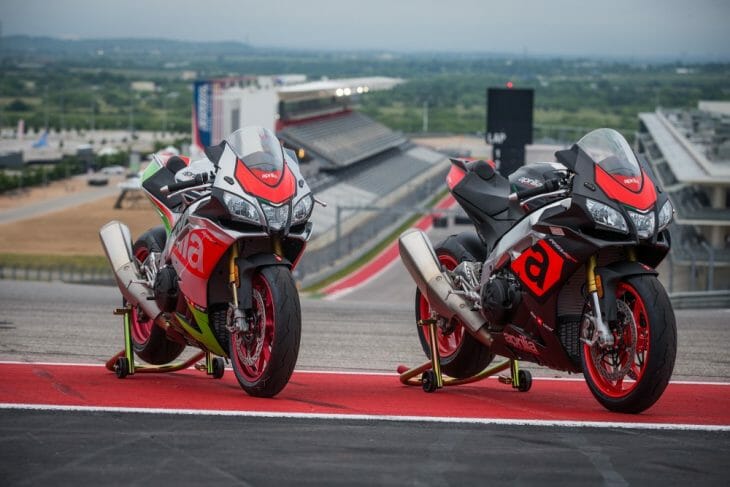 The Aprilia RSV4 RR (right) and RF (left). Either of these will make an exceptional track weapon.
The Aprilia RSV4 RR (right) and RF (left). Either of these will make an exceptional track weapon.
By Mark Miller
The RSV4 has been Aprilia’s greatest success in the past eight years, not only for providing race teams with an ultra-competitive homologated platform in which three World Superbike and one FIM Superstock 1000 Cup Championships were won, but also for amassing critical acclaim for their motorcycle in street trim.
In a world of ever-increasing government regulations on safety, liability, noise and pollution, Aprilia has remained steadfast in trying to keep its flagship V4 RSV4 sportbike at the cutting edge of technology, performance, and reliability. Over the years, they’ve tackled these challenges by implementing subtle but relevant changes to each subsequent model year, including engine enhancements, chassis tweaks, improved rider ergonomics, refined aerodynamics, and especially upgraded electronics.
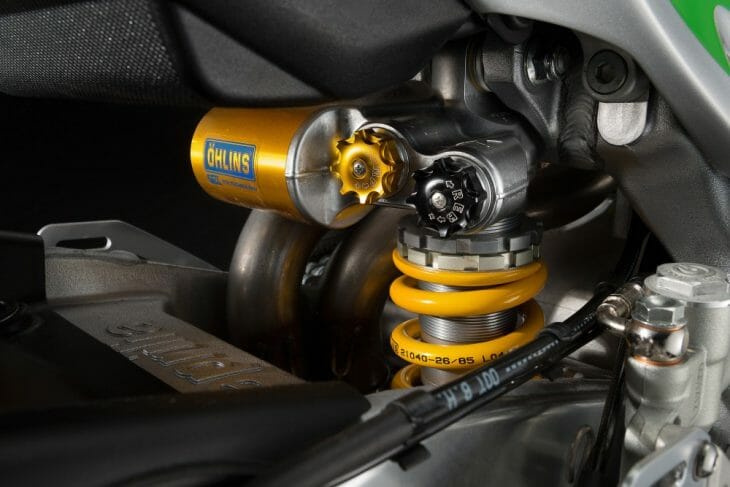 The RF gets Ohlins goodies front and back, as well as lighter wheels and different paint. The engine, chassis and electronics remain the same.
The RF gets Ohlins goodies front and back, as well as lighter wheels and different paint. The engine, chassis and electronics remain the same.
For 2017, Aprilia will again offer the RSV4 in two configurations, the standard RR ABS version (MSRP $16,699) and a limited production RF ABS or “Factory” model (MSRP $22,999).
Both varieties are identical except the RR comes equipped with cast aluminum wheels, Sachs suspension and steering dampener, and is offered in Bucine Gray or Ascari Black paint liveries.
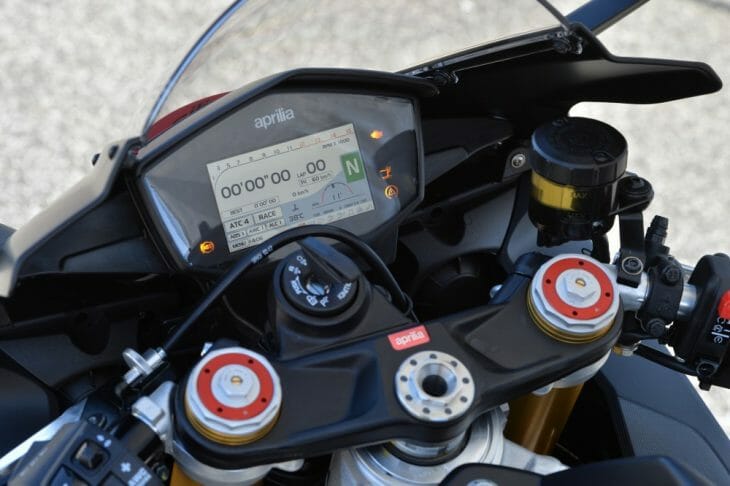 Dash is brand new for 2017 and much easier to read and use than many of the current crop of 1000cc sportbikes.
Dash is brand new for 2017 and much easier to read and use than many of the current crop of 1000cc sportbikes.
The RF is fitted with lighter forged aluminum wheels, the latest generation of lighter Öhlins NIX30 forks with TiN coating, Öhlins TTX36 shock with a new progressive link to increase reaction time, an adjustable Öhlins steering dampener, and is offered exclusively in its ‘Superpole’ paint livery.
Both models now meet strict Euro4 noise and emission standards, but without losing peak horsepower due to an upgraded ECU with a 300rpm higher redline, lighter pistons, revised Pankl connecting rods, a reworked valve train, a new exhaust, reinvented fixed intake ducts, and a reduction in internal friction within the motor.
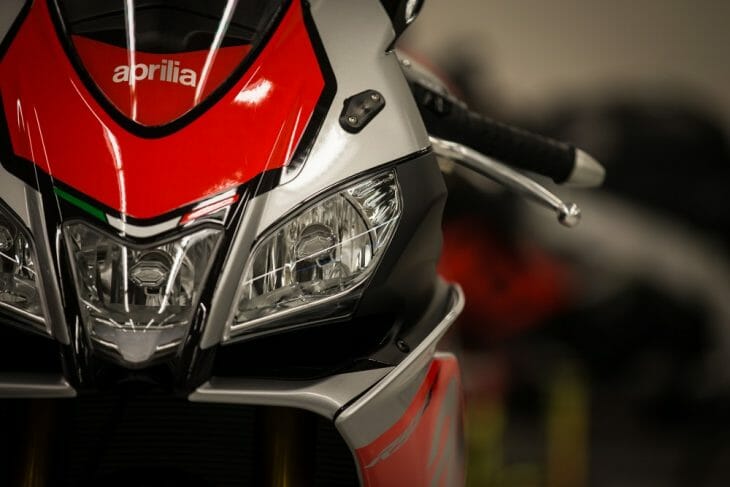 RF gives you the stare. The aesthetics have hardly changed since the RSV4 was released back in 2009, and that’s a good thing.
RF gives you the stare. The aesthetics have hardly changed since the RSV4 was released back in 2009, and that’s a good thing.
I have some personal experience racing Aprilia RSV4s at the Isle of Man TT and Macau Grand Prix from 2011-2013, and they worked pretty good even back then. The only issue was our team was forced to compete on these violent bumpy public road circuits with most available electronic rider aides of the day turned off, because each time we’d get airborne over one of the high speed jumps (a couple of them at over 150mph), the ECU would get confused and sometimes cut power to the engine abruptly, nearly throwing me over the ’bars when I landed into a tank-slapper!
Needless to say, when given the nod to come out to Circuit of The Americas to test the newest Aprilia RSV4 variants with their top-shelf electronics turned on, I was very curious to give it a go.
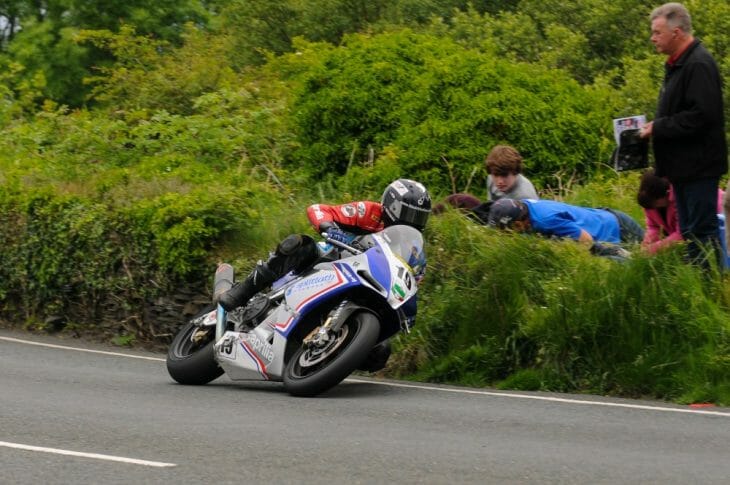 Miller has an affiliation with the RSV4, having campaigned one multiple times at the Isle of Man and Macau Grand Prix.
Miller has an affiliation with the RSV4, having campaigned one multiple times at the Isle of Man and Macau Grand Prix.
Aprilia RSV4 RR on Track
The first couple of laps riding aboard the new RR revealed the bike’s most undeniable characteristic—it’s stability. The amount of confidence-inspiring feedback its aluminum dual beam chassis and Pirelli Supercorsa tires were gave off through the bars in the first 15-minute session of the day was borderline on absurd.
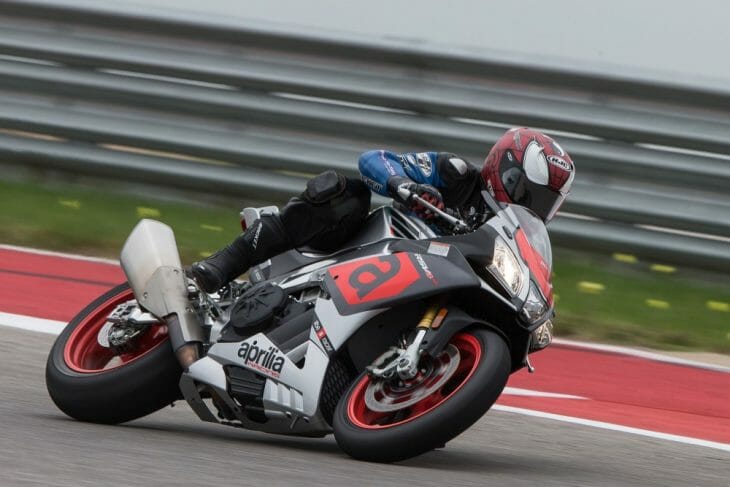 The Sachs-equipped RSV4 RR will be plenty of bike for “90 percent of sportbike riders out there” according to Miller.
The Sachs-equipped RSV4 RR will be plenty of bike for “90 percent of sportbike riders out there” according to Miller.
The second indisputable quality was her beating heart, the Italian V4 motor. It purred not like a sleepy feline, but a pissed-off animal who’d just been released back into the wild, and liked it. Still under control but highly motivated to get the hell out of there, the RSV4 engine offered a powerful rush from down low, a brilliant yank throughout mid-range, and a top end so fierce it took me several laps before I understood that I had to consciously cover the shift lever with my toes before storming up the front strait as not to bounce off the rev limiter like some racetrack virgin. But boy, can she moan! The RSV4’s one of the sweetest sounding engines ever invented.
“Bam, bam, bam, bam,” the RSV4 RR fired noise out the back as I tapped the Aprilia Quick Shift (AQS) system, storming up through the close-ratio six-speed cassette-type gearbox to terminal velocity. On downshift it’s a similar sensation, only the speed is going in reverse. “Ding, ding, ding, ding,” on my way back down the gears without so much as a thought, as spurred on by the RSV4’s brand new auto-blip clutchless down-shift feature, which works brilliantly.
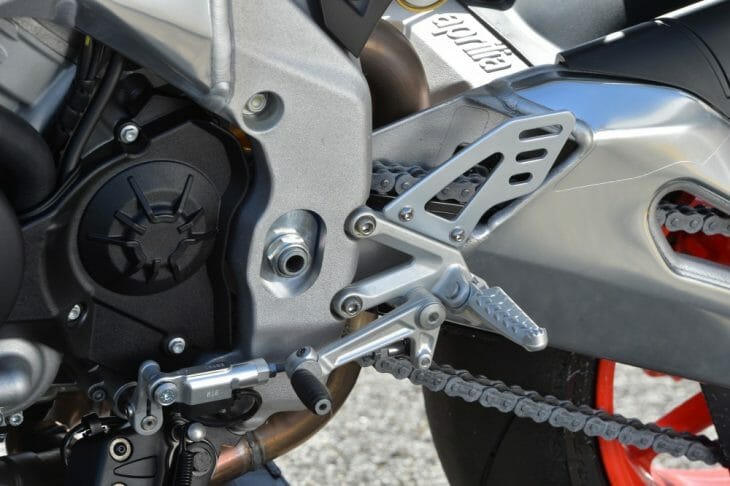 The base model RR gets a quickshifter, unlike what you’ll find on the base Suzuki GSX-R1000 or Honda CBR1000RR.
The base model RR gets a quickshifter, unlike what you’ll find on the base Suzuki GSX-R1000 or Honda CBR1000RR.
The Sachs suspension worked very well and the overall balance and side-to-side direction changes of the RR was spot on. For me at 5’11”, it was good on the rider ergonomics as well and the aerodynamics from the latest generation wind-tunneled bodywork, which was better than I remember from my 2013 RSV4 racebikes.
The new M50 Brembo calipers with their larger 5 x 330mm rotors and upgraded brake pads worked very well all afternoon at track day pace, but when pushed hard towards more ludicrous speeds, the street-comp nature of the braking system exposed some mass-production shortcomings. I was consistently able get the system grumpy enough to where the revised front brake lever would fade to the handlebar and not slow me down, then settle back down and equalize a few corners later. If this was caused by the Cornering ABS system (even when set on Level 1), I can’t approve.
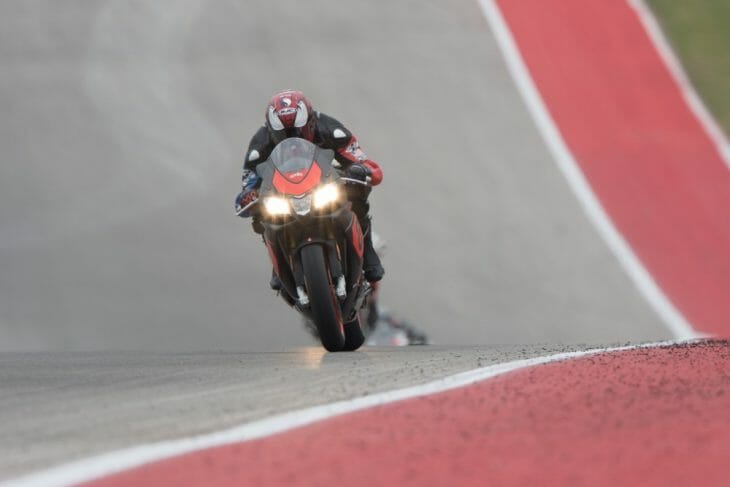 The Aprilia’s top end power rush is perfectly suited to Circuit of The Americas with its massive back straightway.
The Aprilia’s top end power rush is perfectly suited to Circuit of The Americas with its massive back straightway.
But the brakes were simply overheating, which is what it felt like from my experience, swapping out the stock brake fluid for some stupidly expensive fully-synthetic racing fluid could help this issue, as the bike already comes standard with steel braided lines.
There was a lot to play and experiment with regarding the RSV4’s fourth generation aPRC (Aprilia Performance Ride Control) electronics with three engine maps, eight traction control settings—with the option to turn it off—and wheelie control, adjustable to three levels. They pretty much behaved as they should do when not hiccupping on occasion, probably due to an overabundance of data all being thrown into the RSV4 RR’s brain when being ridden really, really, hard.
Aprilia RSV4 RF on Track
Although the Sachs suspension and cast wheels on the RR should be perfectly adequate for 90 percent of the sportbike enthusiasts out there, Aprilia’s RSV4 RF ‘Factory’ model does offer a tangible performance upgrade path with the addition of the newest Öhlins forks, Öhlins shock, and lighter forged aluminum wheels. For the privilege, it will add an additional $6000 to the cost of your new motorcycle.
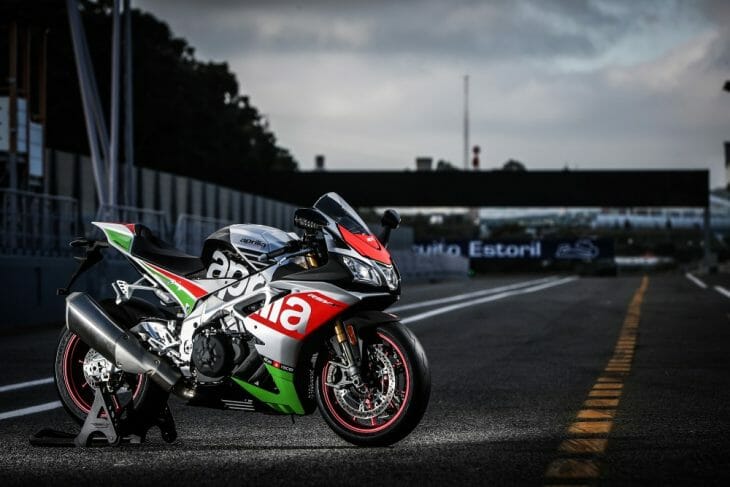 The RF looks lap record fast sitting still, doesn’t it?
The RF looks lap record fast sitting still, doesn’t it?
When first jumping off the standard RR and onto the RF, the advantages of the superior and lighter components become immediately apparent. The bike flicks from left to right with less effort, accelerates harder, reaches top speeds sooner, brakes deeper, and the suspension responds more efficiently to the bumps and imperfections of the racing surface.
And regardless of our experience levels, there is something to gain for every rider when an increase in virility is applied to our current mare. Lighter wheels and a more submissive suspension will, with mathematical certainty, equal improved lap times regardless of the jockey.
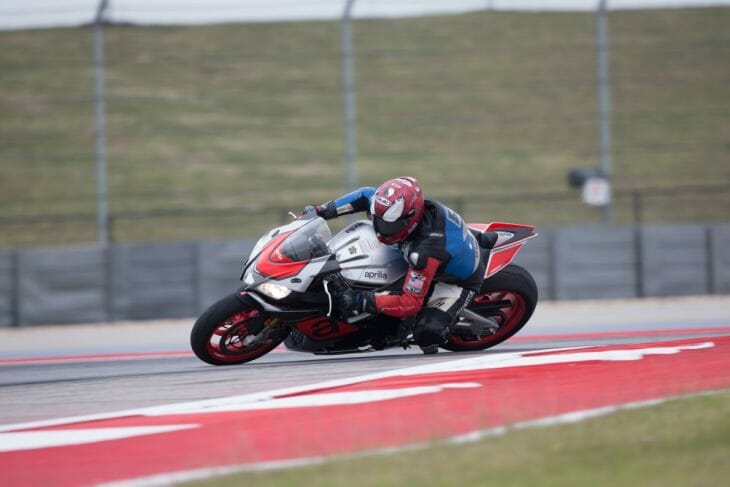 The RF’s lighter wheels and better suspension make for a more potent track weapon.
The RF’s lighter wheels and better suspension make for a more potent track weapon.
The main goal, of course, is to always end the day faster than our best friend, isn’t it?
Is the RF worth the extra $6000 over the RR? In short, yes. Yes, it is. That’s because once we lower that visor and take to the racetrack, all we want to do is reach our very best potential (or our most spritely safe pace). After all the world’s bullshit melts away, we’re left only with one undeniable hunger; to improve our maximum output, tenth by tenth, inch by inch, millimeter by millimeter.
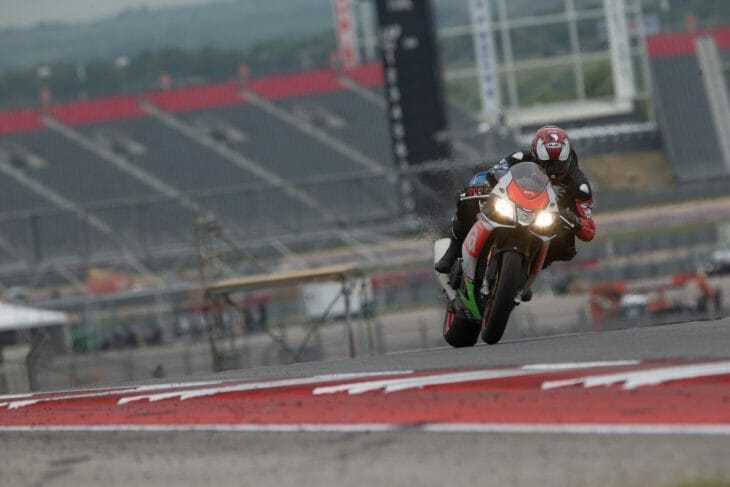 There’s tech on the RSV4 RR and RF even the current MotoGP bikes don’t have, like being able to choose traction control settings based on your location on the racetrack, corner by corner. Neat…
There’s tech on the RSV4 RR and RF even the current MotoGP bikes don’t have, like being able to choose traction control settings based on your location on the racetrack, corner by corner. Neat…
I’m a firm believer in going the extra mile if already 75 percent of the way to my destination.
I say, if I’m going to go as far as buying an Aprilia RSV4 RR, I must as well go all the way and spring for the RF—then lie to my wife that I got the less expensive one of the two bikes. They look almost identical, after all.
Aprilia RSV4 Tech–An Abbreviation Paradise
The RSV4 has always been an amalgamation of sensors, algorithms and mathematical equations. The first commercially available superbike with traction control, anti-wheelie, launch control and a quick shifter, the RSV4 gets all these systems improved for 2017 in both RR and RF form.
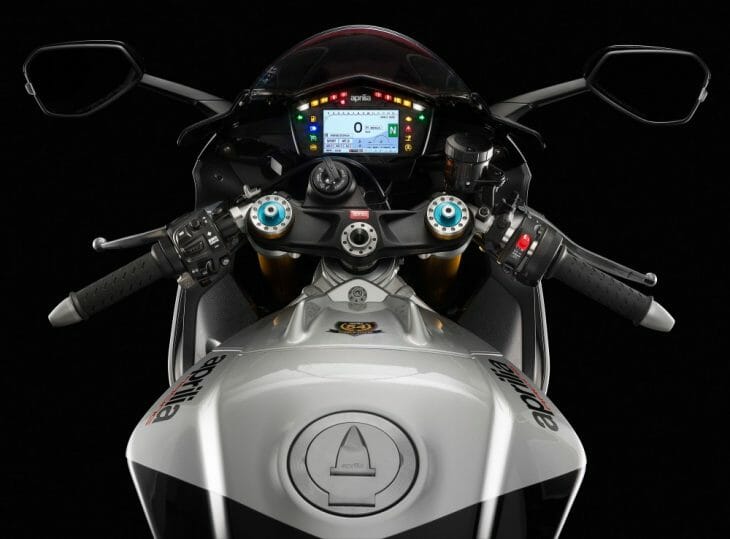 Drop over $20K on an RF and this will be you new office.
Drop over $20K on an RF and this will be you new office.
The traction control (Aprilia Traction Control) system is new, with eight available settings (plus off) thanks to a practical joystick on the left side. This has always been one of the Aprilia’s strong points, because you could tune the system in a race without having to stop like on many competitor bikes.
The three stage AWC’s (Aprilia Wheelie Control) maps have been revamped with more precise operating strategies thanks to the repositioning of the inertial platform. Wheelie control can now be adjusted on the fly without closing the throttle, like ATC, thanks to the new and more practical left side electric block.
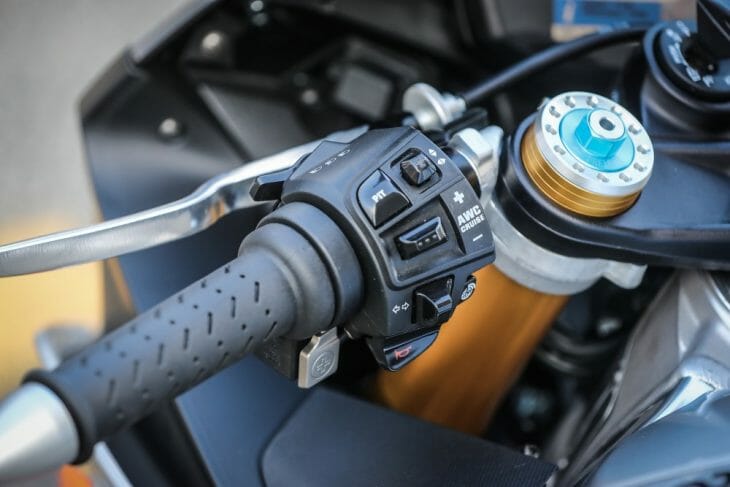 Aprilia’s refined the controls of the RSV4 to make them a bit more intuitive.
Aprilia’s refined the controls of the RSV4 to make them a bit more intuitive.
There’s a new, three stage (ALC) Aprilia Launch Control program, new APL (Aprilia Pit Lane) speed limiter, ACC (Aprilia Cruise Control) system and the AQS (Aprilia Quick Shift) now allows up and down seamless gearshifts, with the added feature of being able to downchange with the throttle wide open—a first for the category.
The V4 engine hasn’t been totally overhauled but still gets lighter pistons, new conrods, a revised exhaust for Euro4 targets as well as a 300rpm increased rev ceiling, while the top end has new valve springs and timing with the variable intake ducts now fixed.
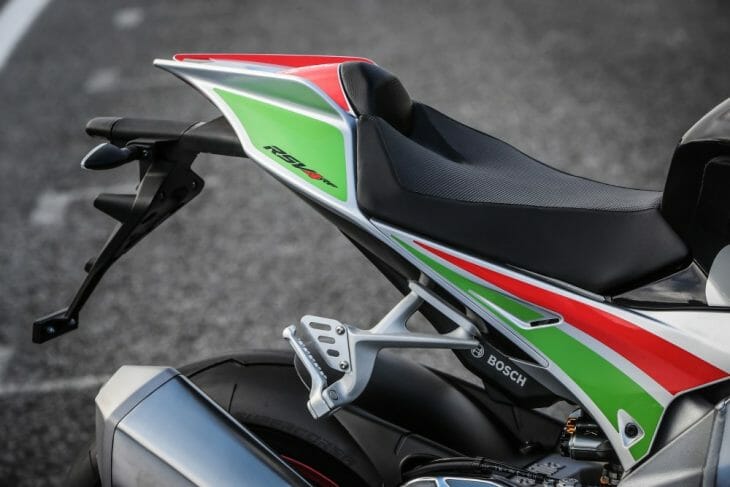 Super svelte back end has always been an Aprilia trademark.
Super svelte back end has always been an Aprilia trademark.
The brakes a new Brembo master-cylinder, and Brembo M50 Monoblocs gripping 330mm discs—the same you’ll find on the Kawasaki ZX-10R or Ducati Panigale—and the switchable ABS control unit is Bosch’s 9.1MP Cornering System with rear wheel lift control.
The higher priced RF gets new, fully adjustable 43mm Öhlins NIX30 forks and an Ohlins TTX36 rear shock, with Sachs taking care of the suspension for the RR version.
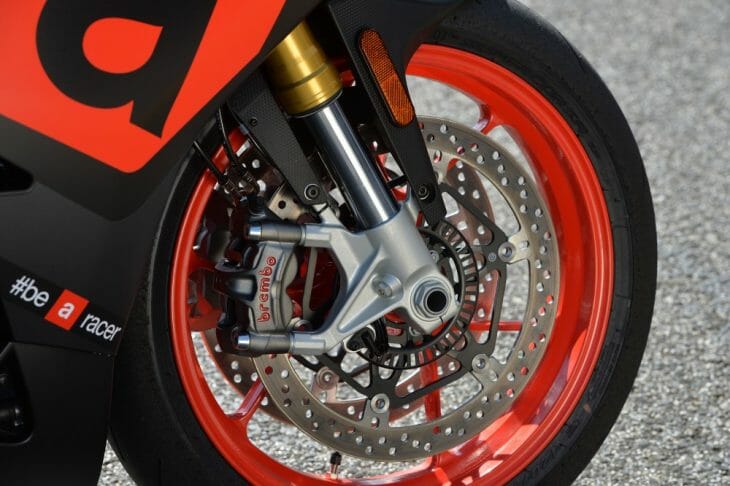 Sachs fork for the RR has been a staple of the base model RSV4 since the beginning.
Sachs fork for the RR has been a staple of the base model RSV4 since the beginning.
The rider interface has been changed as well. The new TFT (Thin Film Transistor) display includes gear indicator, throttle meter, brake meter, lean angle indicator, shift light, pit lane speed, ATC, ABS, AWC, ALC, speed, RPM, clock, low fuel light, etc. The display can be toggled for race track or street riding priority; i.e., larger speedometer or larger gear indicator, and the display background can be toggled black or white for daytime or night use.
Aprilia has long believed in the power of the smartphone and for 2017 they have revamped their V4-MP app that allows you to immerse yourself in virtual telemetry. This is basically a rider performance app and allows you to see where you’re fast, slow, and the different lines you’re taking around the racetrack. It also allows you to program your traction control settings corner by corner, just like the MotoGP teams used to do!
A short history lesson on Aprilia and the RSV4
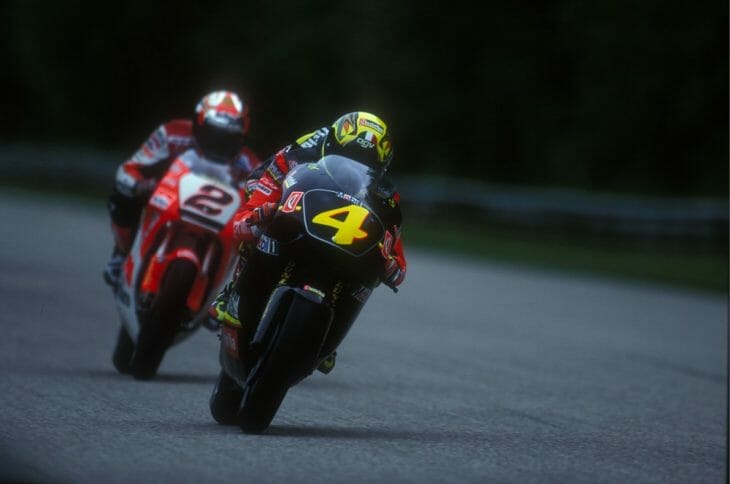 Max Biaggi was Aprilia’s first racing star, taking three 250cc World Championships for the manufacturer in the 1990s.
Max Biaggi was Aprilia’s first racing star, taking three 250cc World Championships for the manufacturer in the 1990s.
To understand the future, you must first understand the past.
Aprilia, founded in 1945 as a bicycle manufacturer, began building and racing motocross bikes in 1976. The company entered Grand Prix road racing in 1985, but jumped up to the 500cc class in 1994.
Shortly after Aprilia settled into the premier category, they became most known for developing the more eclectic motor configurations among the racing community. They campaigned over-bored 250cc V-twin engines against 500cc V4s; they developed a V-twin 500cc two-stroke when most of the grid were on V4s, save for the Modenas KR3; and finally, when MotoGP four-stroke regulations came into effect in 2002, Aprilia campaigned a costly inline triple dubbed the RS3 “Cube” against the Honda RC211V V5, Yamaha YZR-M1 inline four, and the Suzuki GSV-R V4.
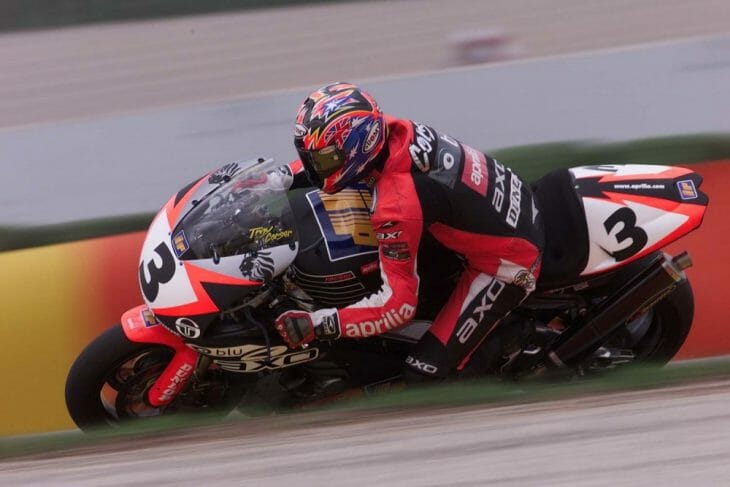 Aprilia’s first go at Superbike was at the turn of the century with the brilliant RSV1000. It nearly won the WorldSBK title with Australian Troy Corser.
Aprilia’s first go at Superbike was at the turn of the century with the brilliant RSV1000. It nearly won the WorldSBK title with Australian Troy Corser.
So, in 2005 when the decision came for Aprilia to build a brand new from-the-ground-up machine to take on the World Superbike Championships, it was no surprise when the manufacturer from Noale, Italy, conceived something special. In the end, they effectively designed a machine gun to bring to a knife fight.
I remember well the years leading up to Aprilia’s official entry back into WorldSBK after their exit from the series in 2002, when they campaigned Rotax-powered twins in their affable RSV1000 Mille chassis, raced by the likes of Troy Corser and Noriyuki Haga and Regis Laconi.
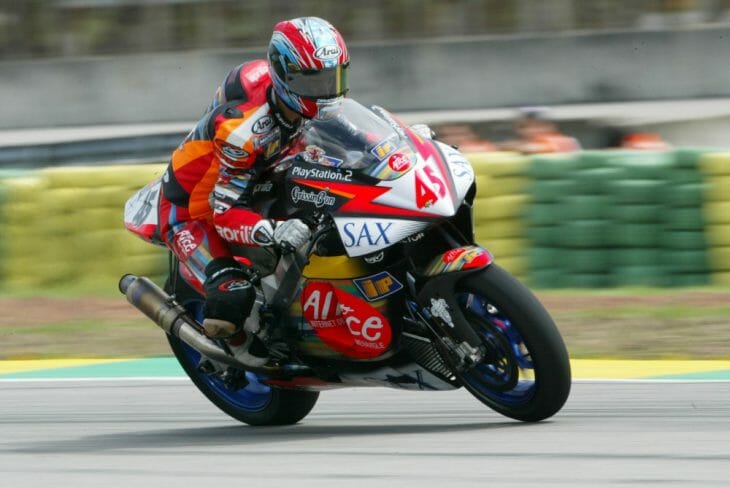 Aprilia teamed with Formula One constructors Cosworth to create the RS3 Cube MotoGP bike of 2003-2005. It sounded great but was a disaster.
Aprilia teamed with Formula One constructors Cosworth to create the RS3 Cube MotoGP bike of 2003-2005. It sounded great but was a disaster.
Fast-forward to 2007—when the likes of Ducati and Casey Stoner began winning MotoGP races and eventually the MotoGP World Championship on their 800cc four-stroke—rumors began to emerge that Aprilia was developing a new V4 four-stroke of their own.
It was not long until Aprilia officially announced it would enter a new Italian weapon not in MotoGP, but World Superbike.
Twenty-five million Euros later in development costs, the RSV4 was unveiled to the world on February 22, 2008, at Piaggio’s International Group Convention in Milan, Italy.
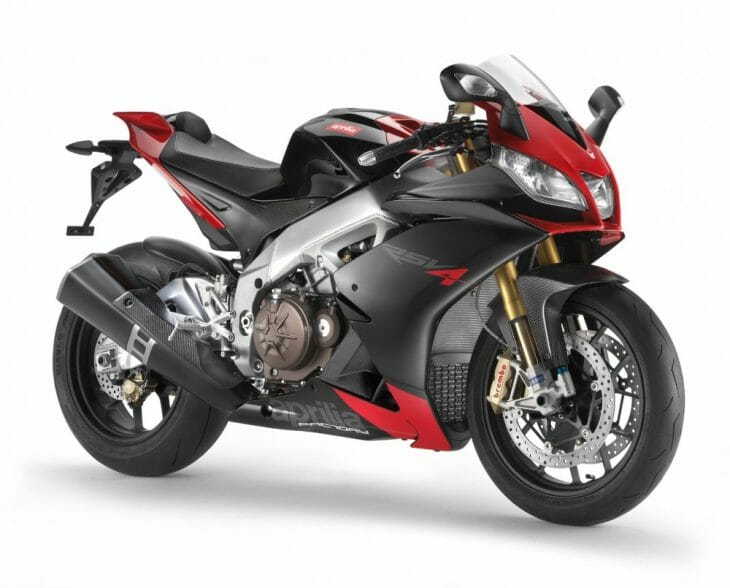 In 2009, Aprilia delivered the RSV4 to a salivating public. It didn’t disappoint.
In 2009, Aprilia delivered the RSV4 to a salivating public. It didn’t disappoint.
One year after the RSV4 was introduced, in the second WorldSBK championship round of the 2009 WorldSBK Championship at Qatar’s Losail International Circuit, Max Biaggi put his new Superbike on the podium.
Max and the RSV4 went on to earn nine podiums that year and one race win. In their second full season they won 10 races earned the 2010 WorldSBK Championship for both rider and constructor—a first for an Italian rider and a first for Aprilia in SBK.
Questions were raised as to the legality of the RSV4. Some in the Superbike paddock insinuated Max’s world title weapon was basically a MotoGP bike in drag, but the truth was the RSV4 was homologated as per the rules of WorldSBK, and you could buy a production version of the racer at your local Aprilia dealer.
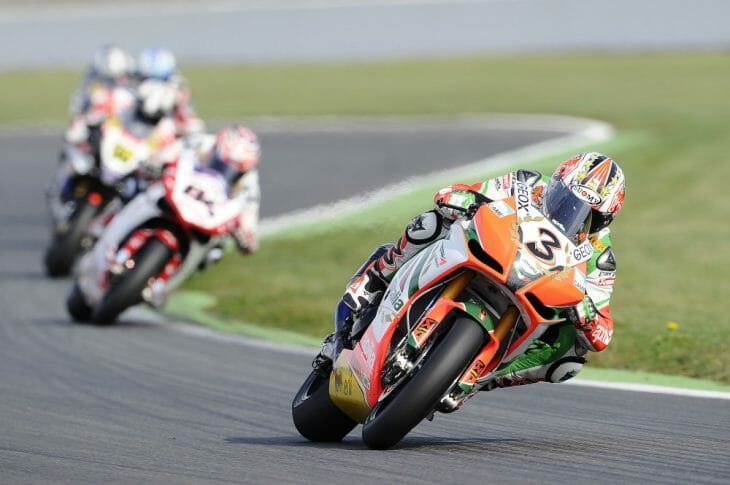 Max Biaggi used the RSV4 to take his first of two WorldSBK titles in 2010.
Max Biaggi used the RSV4 to take his first of two WorldSBK titles in 2010.
The first riding impressions of the 2009/2010 Aprilia RSV4 in street trim were that of universal astonishment by journalists and customers alike. It had a super-compact chassis, aggressive race styling, but the most spoken of feature was it’s expensive sounding, throaty V4 exhaust note which accompanied it’s ferocious, mind-bending mid-range. All stock, and all street legal.
Another attribute of the RSV4 that gathered a lot of chatter at the time was its “Ride-by-Wire” throttle strategy. The RSV4 was the first production superbike to really adapt electronics to suit the ride—quickshifters, traction control, anti-wheelie programs, braking aids—the RSV4 was the ground-breaker.
The original Aprilia engineers knew where electronics were heading, and it continues to happen to this day. Each permutation of the RSV4 from 2009 to 2017 has been characterized largely by the development and improvement of sensors, microprocessors, and its user interface—most often in collaboration with control unit big-wigs like Magneti Marelli and Bosch.
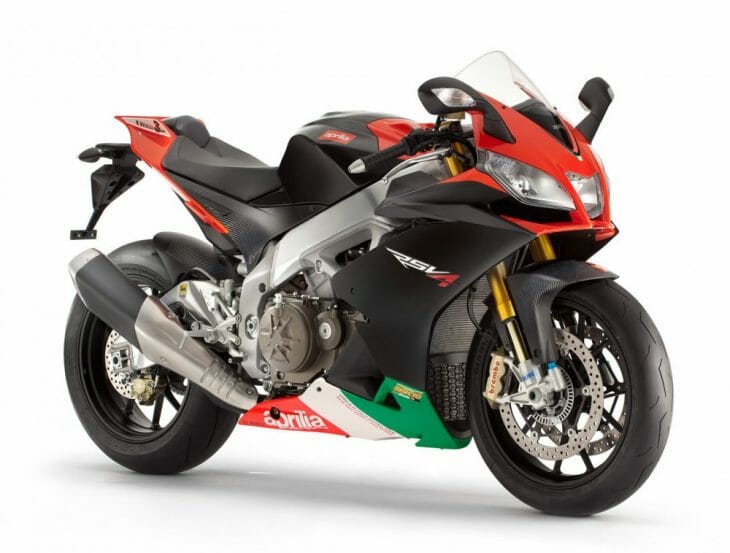 2011’s Aprilia RSV4 was the first production motorcycle to come out with traction, wheelie and launch control, and ABS, setting the benchmark the rest of the world’s manufacturers would follow.
2011’s Aprilia RSV4 was the first production motorcycle to come out with traction, wheelie and launch control, and ABS, setting the benchmark the rest of the world’s manufacturers would follow.
The RSV4’s frame and engine have been mildly modified since its birth to include a CNC-milled combustion chamber, an improved airbox, tweaks on exhausts and gearbox ratios, better aero on the bodywork and mirrors, and eventually lighter valve-trains and improved engine lubrication. But the gist of the bike’s original genesis remains today.
Just to bookend the RSV4’s racing chronicles, in 2014 Aprilia went on to win the WorldSBK Championship again, this time with Frenchman Sylvain Guintoli. Lorenzo Savadori won the FIM Superstock 1000 Cup crown in 2015 on an RSV4, and Claudio Corti won MotoAmerica Superstock races in 2016.
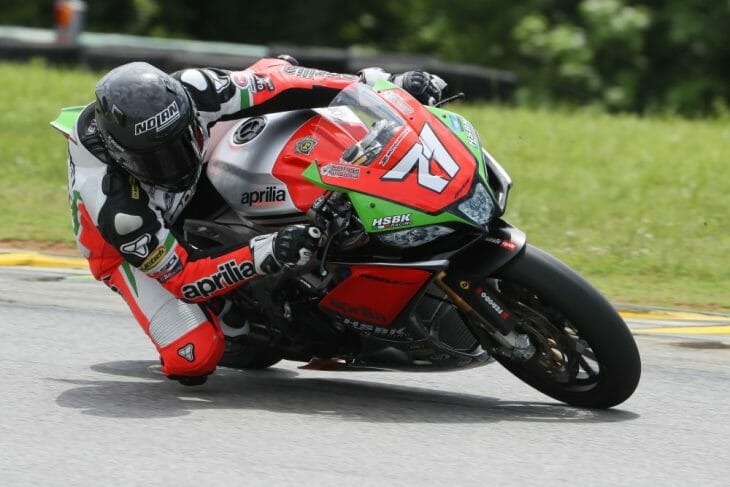 Claudio Corti almost took the 2016 MotoAmerica Superstock 1000 title on board an Aprilia RSV4.
Claudio Corti almost took the 2016 MotoAmerica Superstock 1000 title on board an Aprilia RSV4.
I find it fun to note, however, that the same V4 streetbike motor which Aprilia built to take on the WorldSBK Championship in 2009 and beyond, became the foundation in which a successful MotoGP engine leasing program under the Aprilia Racing Technology banner helped place affordable grand prix horsepower in the hands of MotoGP Claiming Rules Teams (CRT) like Paul Bird Motorsports and Team Aspar.
Funnily enough, these same two teams became the very teams to beat in class for 2012 and 2013—even if powered by souped-up RSV4 Superbike engines. A large piece of Aprilia’s much anticipated new machine unveiled in 2008, which turned out to be a streetbike, went grand prix racing after all.
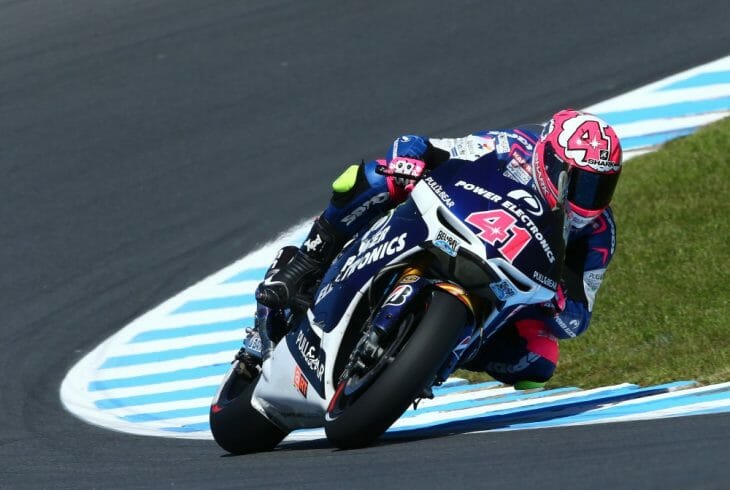 In a funny roundabout way, the RSV4, a bike designed for the street, eventually raced in MotoGP with riders like Aleix Espargaro.
In a funny roundabout way, the RSV4, a bike designed for the street, eventually raced in MotoGP with riders like Aleix Espargaro.
Wonderfully cheeky to me, that.
By the end of 2014, CRTs were replaced by production prototype racers, and Aprilia returned to grand prix racing full-time with a factory effort in 2015.
For the future, rumor has it that the next generation RSV4 is already well in the works. It’s said to have a completely revamped 81mm big-bore engine and totally redesigned chassis.
Specifications
2017 Aprilia RSV4 RR/Aprilia RSV4 RF
Engine: Aprilia V4 65°, four-stroke, liquid-cooled, DOHC, 16 valves
Power: 201hp @ 13,000 rpm (claimed)
Torque: 84.9lb-ft @ 10,500rpm (claimed)
Displacement: 999.6cc
Bore x stroke: 78 x 52.3mm
Compression ratio: 13.6:1
Exhaust: 4-2-1
Transmission: Six-speed
Chassis: Aluminum twin spar
Front suspension: Sachs upside-down fork, 43 mm fork body. Adjustable spring preload, independent rebound and compression/ Öhlins NIX upside-down fork, 43 mm fork body Adjustable spring preload, independent rebound and compression (RF model)
Wheel travel: 4.7 in
Rear suspension: Aluminum alloy swingarm with progressive linkages. Sachs single shock absorber with remote reservoir, adjustable spring preload, independently adjustable compression/ Aluminum alloy swingarm with progressive linkages. Öhlins TTX 36 single shock absorber with remote reservoir, adjustable spring preload, independantly adjustable compression and rebound (RF model)
Wheel travel: 4.7 in
Front brake: Brembo M50 four piston monobloc caliper, 320mm disc. ABS
Rear brake: Brembo single piston, fixed caliper, 220mm disc. ABS
Front tire: 120/70 ZR17
Rear tire: 200/55 ZR17
Wheelbase: 56.5°
Seat height: 33in.
Fuel capacity: 4.9gal
Weight: 450 lb (wet, claimed).
Color: Bucine Gray, Ascari Black/Superpole (RF model)
MSRP: $16,699/$22,999 (RF model)